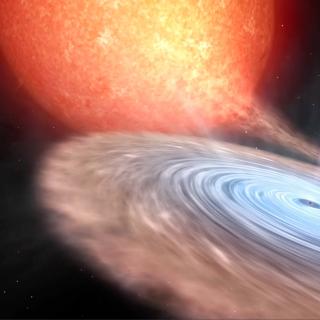Bibcode
Dodge, O. G.; Breton, R. P.; Clark, C. J.; Burgay, M.; Strader, J.; Au, K. -Y.; Barr, E. D.; Buchner, S.; Dhillon, V. S.; Ferrara, E. C.; Freire, P. C. C.; Griessmeier, J. -M.; Kennedy, M. R.; Kramer, M.; Li, K. -L.; Padmanabh, P. V.; Phosrisom, A.; Stappers, B. W.; Swihart, S. J.; Thongmeearkom, T.
Referencia bibliográfica
Monthly Notices of the Royal Astronomical Society
Fecha de publicación:
3
2024
Número de citas
11
Número de citas referidas
11
Descripción
Spider pulsars continue to provide promising candidates for neutron star mass measurements. Here we present the discovery of PSR J1910-5320, a new millisecond pulsar discovered in a MeerKAT observation of an unidentified Fermi-LAT gamma-ray source. This pulsar is coincident with a recently identified candidate redback binary, independently discovered through its periodic optical flux and radial velocity. New multicolour optical light curves obtained with ULTRACAM/New Technology Telescope in combination with MeerKAT timing and updated SOAR/Goodman spectroscopic radial velocity measurements allow a mass constraint for PSR J1910-5320. ICARUS optical light curve modelling, with streamlined radial velocity fitting, constrains the orbital inclination and companion velocity, unlocking the binary mass function given the precise radio ephemeris. Our modelling aims to unite the photometric and spectroscopic measurements available by fitting each simultaneously to the same underlying physical model, ensuring self-consistency. This targets centre-of-light radial velocity corrections necessitated by the irradiation endemic to spider systems. Depending on the gravity darkening prescription used, we find a moderate neutron star mass of either 1.6 ± 0.2 or 1.4 ± 0.2 M⊙. The companion mass of either 0.45 ± 0.04 or $0.43^{+0.04}_{-0.03}$M⊙ also further confirms PSR J1910-5320 as an irradiated redback spider pulsar.
Proyectos relacionados

Agujeros negros, estrellas de neutrones, enanas blancas y su entorno local
Los agujeros negros y estrellas de neutrones en binarias de rayos-X son laboratorios únicos para explorar la física de estos objetos compactos. No solo permiten confirmar la existencia de agujeros negros de origen estelar a través de mediciones dinámicas de sus masas, sino que también permiten investigar el comportamiento de la materia y la
Montserrat
Armas Padilla